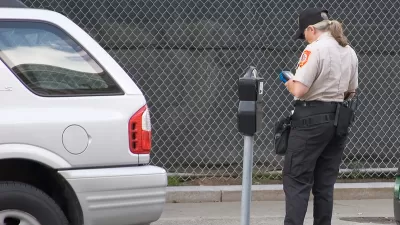Housing on city fringes may be cheaper, but research has shown that after a certain threshold (about 15 miles), the high cost of commuting is no longer offset by it.
"ULI's press release summarizes the findings neatly:
'Housing located far from transit and employment centers places a heavy financial strain on working families in the Washington, D.C. metropolitan region, according to a new publication . . . Beltway Burden documents the challenges faced by area working families who are forced to 'drive 'till they qualify' for housing, incurring higher transportation costs that eventually erode their housing cost savings. It finds that area families are victim to combined housing and transportation costs that constitute, on average, nearly 47 percent of the area median income . . .
'The report points out that 'we need to use our existing infrastructure more wisely and more intensively.' Public policies are needed to preserve the existing stock of affordable housing in the city and older suburbs. More compact development would make public transit more economically feasible and attract retail and other uses, thus reducing congestion, greenhouse gas emissions and transportation costs, the report says.
'These challenges will only increase with the projected addition of 1.7 million new households over the next 20 years in the region.'"
FULL STORY: An in-depth look at location, transportation, and affordability (Part 1: ULI analyzes a metro region)

Alabama: Trump Terminates Settlements for Black Communities Harmed By Raw Sewage
Trump deemed the landmark civil rights agreement “illegal DEI and environmental justice policy.”

Planetizen Federal Action Tracker
A weekly monitor of how Trump’s orders and actions are impacting planners and planning in America.

Why Should We Subsidize Public Transportation?
Many public transit agencies face financial stress due to rising costs, declining fare revenue, and declining subsidies. Transit advocates must provide a strong business case for increasing public transit funding.

Understanding Road Diets
An explainer from Momentum highlights the advantages of reducing vehicle lanes in favor of more bike, transit, and pedestrian infrastructure.

New California Law Regulates Warehouse Pollution
A new law tightens building and emissions regulations for large distribution warehouses to mitigate air pollution and traffic in surrounding communities.

Phoenix Announces Opening Date for Light Rail Extension
The South Central extension will connect South Phoenix to downtown and other major hubs starting on June 7.
Urban Design for Planners 1: Software Tools
This six-course series explores essential urban design concepts using open source software and equips planners with the tools they need to participate fully in the urban design process.
Planning for Universal Design
Learn the tools for implementing Universal Design in planning regulations.
Caltrans
Smith Gee Studio
Institute for Housing and Urban Development Studies (IHS)
City of Grandview
Harvard GSD Executive Education
Toledo-Lucas County Plan Commissions
Salt Lake City
NYU Wagner Graduate School of Public Service





























